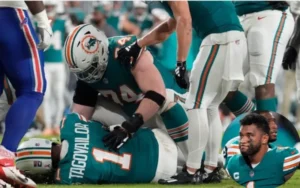The Incident: A Breakdown of the Injury
During a critical matchup, Chris Godwin was involved in a play that would forever alter the course of the game. As the Tampa Bay Buccaneers faced off against their rivals, Godwin, a key receiver, showcased his agility and skill on the field. Late in the second quarter, with the Buccaneers in a crucial offensive drive, Godwin caught a pass from the quarterback. As he made his way downfield, he was swiftly met by a defensive player, resulting in a jarring collision that raised immediate concern amongst fans and teammates alike.
The play unfolded rapidly, with Godwin attempting to evade the defender. However, the impact of the tackle was substantial, leading to an apparent injury to his knee and leg area. Commentators on the broadcast quickly shifted their focus to the injury, noting the severity of the contact. Medical staff rushed onto the field, their urgency further highlighting the alarming nature of the incident. The atmosphere was tense, with viewers holding their breath as they awaited updates.
In the immediate aftermath, the response from the coaching staff and medical personnel was a mix of caution and urgency. Coaches were seen conferring with medical staff, assessing the situation. At one point, Godwin was down on the field and appeared to be in visible pain, prompting questions about the decision to leave him in the game during such a pivotal moment. Insightful discussions arose among commentators about player safety, emphasizing that the decision-making process for keeping players on the field should always prioritize their well-being. This incident not only impacted Godwin and the Buccaneers but also sparked broader conversations around injury protocols in professional sports.
Understanding Player Safety Protocols
The National Football League (NFL) places a significant emphasis on player safety through a set of established protocols designed to protect athletes during games. These protocols include comprehensive assessments by medical personnel, injury timeout procedures, and strict guidelines governing players’ return to the field after injury. The aim is to minimize the risk of long-term damage and ensure athletes are fit to continue competing.
Each team is equipped with certified medical staff tasked with evaluating players on the sidelines. When a player is believed to have sustained an injury, the medical personnel evaluate the severity of the situation, including conducting assessments for concussions or other significant injuries. During this process, injury timeout protocols are activated, allowing medical teams to intervene and assess the player without the constant pressure of the game clock.
Additionally, the NFL has instituted return-to-play guidelines that stipulate the necessary criteria a player must meet before they can rejoin the game. These involve a step-by-step evaluation, ensuring that athletes have fully recovered from any injuries and are not at risk of exacerbating their condition. However, questions often arise about the adequacy of these protocols, especially in high-stakes scenarios such as Chris Godwin’s injury.
In situations where the intensity and pace of the game may overshadow medical assessments, concerns emerge regarding whether the existing safety protocols are applied effectively. Discussions around player safety frequently raise the point of human oversight, as decisions made in real-time could impact players’ futures. In this context, understanding and enhancing player safety protocols remains a fundamental aspect of the ongoing conversations within the NFL community.
Coach’s Decisions: Risk vs. Reward
The decision-making process of coaching staff during a game is often multifaceted, particularly when it comes to player management. In the case of Chris Godwin, who sustained an injury yet remained on the field, the complexities of these decisions become evident. Coaches must weigh the immediate benefits of keeping a player like Godwin in the game against the potential risks to his health and future performance. This balancing act hinges on various factors including team strategy, player fitness levels, and the game situation.
One significant aspect contributing to such decisions is a team’s strategic approach. For instance, if a team is trailing late in a game, the urgency to field their most skilled players can override concerns about a player’s physical condition. The belief that Godwin’s playmaking abilities could turn the tide may have led the coaching staff to prioritize short-term gains over long-term player well-being. Moreover, the dynamics of competition can unreasonably pressure coaches to keep star players active, despite their injuries.
However, this strategy of pushing players’ limits raises essential questions about the broader implications for player welfare. The decision to keep an injured player in the game can lead to exacerbated injuries, potentially sidelining them for an extended period and affecting their overall career trajectory. The ongoing dialogue surrounding this balance involves not only player health but also long-term team performance; a compromised player may not meet their peak performance standards even after recovering.
Ultimately, while the competitive nature of sports drives teams to make risky decisions, it is crucial for coaching staff to reflect on the ethical implications of their choices. Striking a balance between competitiveness and player safety is essential for fostering not just team success but also the longevity of athletes’ careers.
The Aftermath and Repercussions for Godwin and the Team
The injury sustained by Chris Godwin has left a significant mark not only on his personal career but also on the entire team’s dynamics and future performance. The wide receiver faces a challenging recovery timeline, with reports suggesting that he may require several months of rehabilitation before he can return to play. Such a setback raises concerns about long-term effects on his mobility and overall effectiveness as a player. The nature of the injury is often associated with prolonged recovery periods, leading to speculation about whether his career trajectory might be altered as a result.
In addition, this injury poses a considerable challenge for the coaching staff as they work to fill the void left by Godwin. Adjusting game strategies without one of their star players could affect the team’s performance in upcoming matches. This situation not only involves on-field tactics but also how the remaining roster members respond to increased pressure. Players who must step up in Godwin’s absence will need to deal with heightened expectations, potentially leading to shifts in team chemistry.
The fan and analyst reactions have been immediate and intense, with discussions focusing on player safety in the NFL. Many are questioning the protocol that allowed Godwin to remain in the game prior to sustaining his injury. The incident reignites debates surrounding the necessity for stricter regulations regarding player safety and injury management in professional football. As injuries like Godwin’s continue to dominate headlines, a call for reform in how the league approaches player welfare becomes increasingly paramount.
In conclusion, Godwin’s injury extends beyond personal ramifications. It highlights critical discussions regarding player safety in the NFL and the broader implications for teams and players during high-stakes situations. The ongoing dialogue about necessary changes in the league is a testament to the urgent need for reform in ensuring the safety and longevity of athletes’ careers.




